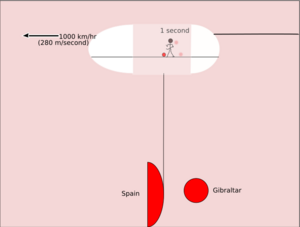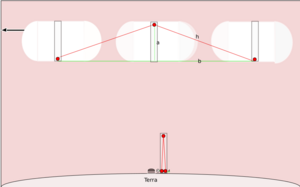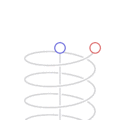Light clock facts for kids
The light clock is a cool idea that helps us understand a key part of Special relativity. Imagine a special clock that works by bouncing a flash of light between two mirrors. It sends a light flash, waits for it to hit a mirror and come back, then sends another flash. It counts how many flashes have happened.
If you were on Earth watching a super-fast spaceship fly by with one of these clocks, you would see its clock ticking slower than your own. This amazing effect is called time dilation.
Contents
Relative Motion: The Basketball Example
Before we dive deeper into the light clock, let's think about how motion looks different to different people. Imagine someone dribbling a basketball inside a huge cargo airplane. The person and the ball are moving in the same direction as the plane.
To someone else inside the plane, the basketball player moves just a meter or two with each dribble. About one second passes between bounces. But what if you were watching from the ground? When the ball bounced the first time, it might have been over Gibraltar. When it bounced again, it would be over the water closer to Spain. So, from the ground, the basketball moved about 280 meters! This shows how motion is relative to who is watching.
How a Light Clock Works
Now, let's look at the light clock itself. It's built with a light source at the bottom of a tall pole, a mirror at the top, and a light detector at the bottom.
Here's how it "ticks":
- A tiny flash of light shoots up from the bottom.
- It hits the mirror at the top and bounces back down.
- When the light detector at the bottom sees the flash return, it does two things:
* It adds one to a counter. * It immediately sends another flash of light up to the mirror.
Since light travels incredibly fast (about 300,000 kilometers per second!), this clock ticks many, many times each second.
To make the math a bit easier, let's say the pole is half a kilometer (0.5 km) long. So, for one "tick" (light going up and down), the light travels a total of 1 kilometer.
We know that: distance = speed × time
For our light clock, the distance is 1 km, and the speed is the speed of light, which scientists call c. So, 1 km = c × time per tick
If we use the speed of light (300,000 km/second), then: time per tick = 1 km / 300,000 km/second = 0.00000333... seconds. That's a very tiny fraction of a second for each tick!
Time Dilation: Clocks in Motion
Now, imagine a spaceship flying very, very fast, almost at the speed of light, right over the North Pole. This spaceship also has a light clock inside it.
For the people inside the spaceship, their light clock works exactly the same way as the one on Earth. The light goes straight up and straight down between the mirrors.
But for people on Earth watching the spaceship fly by, something different happens. Because the spaceship is moving so fast, by the time the light flash reaches the top mirror, the mirror has moved forward a bit. Then, as the light bounces back down, the bottom detector has also moved forward.
This means the light has to travel a longer, diagonal path (like the line marked h in the diagram) to go from the bottom mirror to the top, and then back down again.
Even though the light travels a longer path, its speed (c) is always the same for everyone, no matter how fast they are moving. Because the light has to cover more distance at the same speed, it takes more time for one "tick" to happen on the moving spaceship's clock, as seen from Earth.
This is the amazing part of Special relativity: time itself slows down for objects that are moving very fast relative to you.
The formula that describes this is: t' = t / √(1 - r2/c2)
- t' is the time measured on the moving clock (as seen from Earth).
- t is the time measured on a stationary clock (like the one on Earth).
- r is the speed of the spaceship.
- c is the speed of light.
This formula shows that if the spaceship's speed (r) gets closer to the speed of light (c), the bottom part of the equation (√(1 - r2/c2)) gets smaller. When you divide by a smaller number, the result (t' ) gets bigger. This means the time for one tick on the moving clock (t' ) is longer than a tick on the stationary clock (t). So, the moving clock ticks slower!
For example, if a spaceship travels at half the speed of light, one second on its clock would be about 1.15 seconds for someone on Earth. The faster you go, the more time slows down for you compared to someone standing still.
You can try experimenting with different speeds here: Experiment with speeds
Real-World Time Dilation
Time dilation isn't just a theory; it's a real effect! It's very important for things like the GPS satellites that help you find your way. GPS satellites orbit Earth at high speeds and are also in a weaker gravitational field. Both of these factors cause time to pass slightly differently for them compared to clocks on Earth. Without correcting for time dilation, GPS systems would quickly become inaccurate by many kilometers!
Images for kids
-
Time dilation explains why two working clocks will report different times after different accelerations. For example, time goes slower at the ISS, lagging approximately 0.01 seconds for every 12 Earth months passed. For GPS satellites to work, they must adjust for similar bending of spacetime to coordinate properly with systems on Earth.
-
Daily time dilation (gain or loss if negative) in microseconds as a function of (circular) orbit radius r = rs/re, where rs is satellite orbit radius and re is the equatorial Earth radius, calculated using the Schwarzschild metric. At r ≈ 1.497 there is no time dilation. Here the effects of motion and reduced gravity cancel. ISS astronauts fly below, whereas GPS and geostationary satellites fly above.
See also
 In Spanish: Dilatación del tiempo para niños
In Spanish: Dilatación del tiempo para niños








